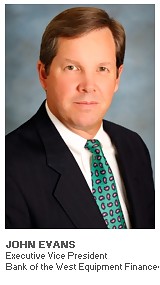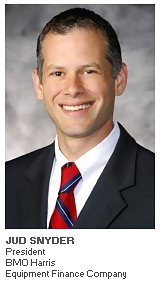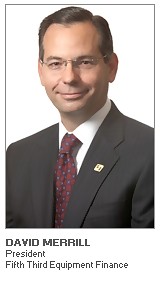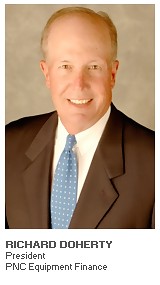 Opportunities and Challenges Will Come From All Directions in 2014
Opportunities and Challenges Will Come From All Directions in 2014
By: Stuart P. Papavassiliou
Date: Apr 22, 2014 @ 07:00 AM
For the second year in a row, Equipment Finance Advisor brings together a panel of four industry leaders to share their impressions as to how the industry is faring thus far with one quarter behind us. In the following roundtable discussion, John Evans, Jud Snyder, David Merrill and Richard Doherty share the view that in general, 2014 is shaping up quite nicely. In spite of the chilling effect that the harshest winter in recent times had on the economy as a whole, most equipment sectors, with the exception of healthcare, are showing strength if not promise. These executives make the point that risk management is an ever-constant reality as are intense competition and areas of uncertainty caused by lease accounting and macro-economic issues.
While the consensus is generally the same, each executive voices their unique perspective on what it takes to succeed in the current environment with both candor and clarity. As such, we express our thanks to Rich, Dave, Jud and John for the thoughtfulness of their responses and their generosity of spirit.
In closing, we ask you, our readers, to take a moment and share your views as to how the industry is faring in the Comments From Our Members feature provided below.
Feel free to read these four perspectives in any order you prefer.
Bank of the West Equipment Finance: Leveraging a Global Presence
John Evans
Bank of the West's John Evans maintains a bright outlook on the equipment finance industry for the remainder of 2014 and intends to leverage BNP Paribas' global capabilities to both strengthen existing relationships and develop new opportunities.
Equipment Finance Advisor: Now that the first quarter is behind us, could you share your thoughts on how the equipment leasing and finance industry is faring thus far in 2014? As a follow up, please share your outlook for the remainder of the year with regard to Bank of the West Equipment Finance’s key sectors.

John Evans: Assuming Bank of the West Equipment Finance is a good proxy for the state of our industry, I would say the industry is quite active and doing very well. In spite of the difficult weather conditions that plagued much of the country this winter, our first quarter new business activity was up 30% year-over-year. We saw very robust activity in all business sectors except for one … healthcare. That sector seems to be experiencing the dampening effect of uncertainty.
From an economic standpoint, I think the outlook is bright for the rest of the year. We saw industrial production rebound in February after a bit of a lag which was attributed to the severe weather. Recently, we also saw the ISM Manufacturing Index register its second month of improvement. All these things suggest that industrial businesses will increase investment in plants and equipment. Hopefully that will follow in other sectors to help drive the demand for equipment financing. We’re looking for a very strong 2014 and I think that will carry over into 2015.
Equipment Finance Advisor: From your institution’s standpoint, what are the directives you are receiving from your senior management given today’s economic climate? Are you focusing primarily on risk management, portfolio growth, leveraging existing relationships or on something else?
Evans: Since Bank of the West is owned by BNP Paribas, we work with BNP Paribas Leasing Solutions, one of the largest equipment leasing and finance entities in the Eurozone. Our affiliation with BNP lets us provide the tailored, local service our clients expect along with the global resources and reach of one of the world's strongest financial groups. This puts us in a particularly strong position here in the U.S. to grow in two strategic areas: vendor finance and direct equipment finance. We are being asked to capitalize on this potential by delivering our institution’s comprehensive array of financial products and solutions to our clients and business partners within the equipment finance business. Relationships are really the core focus for Bank of the West and BNP, and our goal is to strengthen those relationships by leveraging all of our capabilities to help clients grow.
Equipment Finance Advisor: What would you say are the issues that are “top of mind” for your direct clients and your vendor partners? Are the issues different between your vendor relationships and your direct clients?
Evans: In general, we are hearing the same things from our vendor partners and our corporate clients. We are hearing more optimism but there is still an undercurrent of uncertainty. It’s the lingering effect of the difficult years we had in 2008 through 2010 and our partners and clients are still being very vigilant. They want to be optimistic but they are sensitive to any perceived or potential changes that may impact the economy adversely.
Equipment Finance Advisor: Looking at the equipment leasing and finance industry as a whole, what are the biggest challenges you and your colleagues face going forward either today or in the near future?
Evans: From what I’m hearing and reading as well as from what I am experiencing here at the bank, our industry has reached a low point in terms of the credit cycle. If you look at the statistics being published, delinquencies, problem accounts and charge-offs are all at historic lows. Last year we were in a net recovery position for most of the year. Now the question is how long will this part of the cycle last? In past cycles as more capital came into the industry, competition intensified. Pricing compressed and underwriting and structuring got looser. At Bank of the West, we have always maintained prudent underwriting standards, so our portfolio held up quite well.
I think there might be a different dynamic in the current cycle. Banks are being scrutinized to a far greater extent by regulators this time around. It will be interesting to see the impact this different dynamic will have on this credit cycle. It may have a dampening effect in terms of underwriting and structuring since the regulators are far more involved as they look closely at banks’ lending practices. This regulatory activity may also extend to non-bank financial firms … particularly the larger firms that may be considered systemically important. While that hasn’t happened, there are discussions of that nature out there.
BMO Harris Equipment Finance Company: Setting Sights on a Business-Led Recovery
Jud Snyder
For Jud Snyder at BMO Harris Equipment Finance, all signs point toward business expansion. Snyder assures that he and his colleagues take their corporate responsibility to finance a business-led recovery quite seriously.
Equipment Finance Advisor: As we have just completed the first quarter, please give our readers your perspective of how the industry is faring thus far in 2014? Also, please share your outlook for the year in terms of the markets you serve and the equipment types you finance.

Jud Snyder: I’d say the industry is faring very well and I look to a few reference points – both anecdotally and from industry data -- to substantiate that view. According to the latest MLFI-25, new business volume is up 15% in February 2014 versus February 2013 and year-to-date volume is up 8% from 2013. That indicates continued growth and economic reinvestment activity. Industry head count is also up and credit approval rates have flattened out a bit but are still at the top of historical cycles. Our business at BMO Harris Equipment Finance is continuing to grow rapidly and we are hiring new employees to meet the needs of our growing customer base.
Our business is a national business and we are seeing expansion in all markets. From an industry sector perspective, BMO Harris Bank has significant expertise in food and agribusiness lending, engineering and construction and energy and transportation to name a few. These are all areas that dovetail nicely with our cross-sell efforts with our equipment finance business and they have been bright spots for us this year. The industry “hot spots” for our equipment finance business have been transportation finance, food and agribusiness lending and our corporate aviation finance vertical we launched 18 months ago. We’ve seen significant flow in terms of both fixed-wing and rotary assets in that business and we expect that vertical to continue to grow over the next 12 to 18 months.
Equipment Finance Advisor: From your institution’s standpoint, what is the primary directive you are being asked to deliver on by your senior management? Is it portfolio growth, risk management, expanding relationships within your institution or something else not mentioned here?
Snyder: I would say all of it, but in terms of specifics, we are in somewhat of a unique position. The equipment finance business is still relatively new to the bank and we’re small in terms of relative scale. BMO Harris is very well capitalized, liquid and looking to lend, so from that perspective, the equipment finance business is a great transactional tool for us to both build existing relationships as well as lead into new relationships.
As part of a large North American Bank and especially a Canadian bank, we always have our eye toward risk management. I would also mention that as an institution, we take our corporate responsibility to help finance a business-led recovery very seriously. We believe the U.S. economy is strengthening and we see ourselves as having an important role in supporting that recovery.
Equipment Finance Advisor: What concerns, if any, are you and your team hearing from your clients in terms of investing in equipment this year?
Snyder: Honestly, our people are hearing fewer concerns these days, but there is continued concern over the political climate. For the most part, I think many of the acute concerns have started to subside. The lessees do have questions about FASB and IASB convergence, but much of that becomes a question of financial instrument structure than any question about whether or not they are going to invest. BMO Harris recently released a study that showed 64% of the small business owners and 82% of larger companies in our sample are planning on investing in their businesses this year. The question then becomes whether these borrowers will use cash or will borrow to finance their expansion. The study showed that larger companies are still very liquid and many of them anticipate using cash for a portion of their expansion.
Equipment Finance Advisor: With regard to the industry as a whole, what are the challenges the industry faces today and in the near future?
Snyder: The biggest ones are lease accounting convergence and margin compression. I’ve given up trying to predict what the Boards are going to wind up with regarding lease accounting, but I think it’s safe to say that leases will wind up on balance sheets. The biggest issue from an industry standpoint is that this uncertainty makes it difficult for borrowers and lessees to make accurate evaluations of finance options. As a result, many of the larger borrowers may be swayed to pay cash when they elect to invest in equipment.
In terms of margin compression, this is a reality in our industry and it’s my belief that barring some big event, this is unlikely to change in the intermediate term. There is just a huge amount of liquidity in the system and even with the economy recovering, there is a supply and demand issue causing this continued compression. Equipment finance companies need to figure out how to be more efficient and leaner and drive non-interest revenue. Those companies that accomplish this are going to survive and thrive in this cycle.
Fifth Third Equipment Finance: Seeing Overall Growth in Spite of Economic Potholes
David Merrill
Fifth Third's David Merrill expects to see overall growth in the overall marketplace in the foreseeable future. Still and all, Merrill says the economy is still experiencing some "bumps in the road" that is causing a bit of caution in the marketplace.
Equipment Finance Advisor: We have just completed the first quarter. Can you give our readers your sense of how the industry is faring so far this year along with your outlook for rest of 2014?

David Merrill: In general, the economy is gradually improving. With the GDP anticipated to rise at 2.5% to 4%, and unemployment rates decreasing to 6.7% confidence in the economy is also improving. Despite this positive momentum, I still anticipate some bumps in the road for the economy as a whole. The same is true in the equipment leasing and finance industry. Investment in equipment is expected to grow at 4.2% according to the latest outlook produced by the Equipment Leasing and Finance Foundation. Companies are hiring aggressively, charge-off and delinquency levels are low as compared to historical levels and we are seeing new entrants coming into the marketplace. These are examples of positive momentum, but we are going to continue to experience some challenges in our industry as well. There’s still some caution in the marketplace, so while things are generally very good, they are not universally positive.
In terms of the foreseeable future, I think we are going to continue to see steady growth in the overall marketplace. At Fifth Third Equipment Finance, we have been doing well across all of our regions and our growth is becoming increasingly dependent on finding the industries and equipment types that provide the greatest opportunities. For example, we’ve seen really strong growth in rail equipment over the past year. However, the values for coal cars have been very soft and after a few well publicized accidents, there has been a lot of discussion about the future of crude oil tank cars. In the end, while we are still cautious about certain parts of the rail market, we are very optimistic about the sector in general.
We have also been seeing strong growth in trucking, marine and construction equipment, but certain parts of these markets are better than others. We are being diligent and focusing on the parts of the marketplace that offer the greatest opportunity for growth with the least risk.
Equipment Finance Advisor: From your institution’s standpoint, what is the primary directive you are being asked to deliver on by your senior management? Is it risk management, portfolio growth, expanding relationships within your institution or something else?
Merrill: These are interesting times. There is a lot of excitement around our business and we have big plans for growth, so we are focused on a number of activities this year. All of our staff members are engaged in building the foundation in addition to tending to their day-to-day responsibilities. Like everyone else, we are heavily focused on portfolio growth. This year we are expanding our geographic coverage as well as aligning resources toward certain vertical markets to support Fifth Third’s Relationship Managers developing expertise in these markets. We are also exploring some new market segments as part of our long-term growth strategy.
We are very focused on our customer experience. Our objective is to become our clients’ trusted advisor and to provide creative solutions for their equipment finance needs. Then we aim to expand the equipment finance relationship into a broader banking relationship.
We are also working on technology enhancements to improve our overall efficiency. We have a lot of resources aligned at that initiative right now. We are currently very focused on our talent acquisition, retention and development.
Equipment Finance Advisor: What concerns, if any, are you and your team hearing from your clients in terms of investing in equipment this year?
Merrill: Our customers are currently concerned with macro-level issues. They are concerned with the continuity of economic growth, uncertainty surrounding tax policy and the possibility of the United States becoming involved in foreign conflicts. Some are concerned about the long term consequences of the Affordable Care Act. While their sentiment is positive overall, they remain wary. They don’t feel that the economic engine is firing all cylinders right now.
I’m not hearing about concerns over lease accounting changes from our customers. Lease accounting is just one of the reasons our customers choose the leasing solution for their equipment financing needs. In the end, a change in lease accounting may alter the mix of loans to leases we originate, but the demand for equipment financing will remain unchanged. A few borrowers may convert to cash, but that will not shift the supply/demand equation significantly.
Equipment Finance Advisor: With regard to the industry as a whole, what are the challenges the industry faces today and in the near term?
Merrill: Tax policy is always concerning to me. As equipment finance professionals, we must be engaged in advocacy efforts to avoid any unintended consequences of tax policy changes that will impact our industry. While bonus depreciation accomplished the goal of stimulating investment in equipment, it probably led lessors to achieve a slightly lower mix of true leases versus loans in their portfolios. That’s because when rates are low and customers are in a taxable position they are more likely to conclude they would be better served to to purchase the asset with borrowed funds and take the immediate depreciation deduction. With tax policy, there are always intended consequences and occasionally, unintended consequences.
As a general concern, each time the competition becomes more intense, it tends to lead toward margin compression and relaxed structures. When that happens – and I’ve been around awhile – those trends are precursors to the next market correction.
PNC Equipment Finance: Giving Credit Where It's Due
Richard Doherty
PNC Equipment Finance's Rich Doherty makes no bones about it: a career in equipment leasing and finance is both challenging and satisfying. One of his commitments is to continue to attract young talent to the industry, which in his estimation, doesn't always get the credit it deserves.
Equipment Finance Advisor: As we have just completed the first quarter, can you give our readers your perspective as to how the equipment leasing and finance industry is faring thus far in 2014?

Richard Doherty: I think the industry is in good shape. The challenge the industry faces as a whole is there is more and more competition and it seems everyone is chasing the same deals. The question we ask ourselves is can we get more market share and accomplish the type of growth we are out to achieve?
But in terms of the business, we see things are picking up in transportation and technology sectors. The software business continues to maintain strong growth while healthcare continues to be on the lighter side. It seems as though the CEOs in the healthcare organizations are maintaining a stance of “wait and see” when it comes to incremental or discretionary purchases. At the same time, we did see some huge medical record opportunities in the first 60 days; but in general I think the prevailing view is to wait and see what happens.
Geographically we feel pretty good about all of our markets throughout our 20-state footprint. It’s a bit slower in the Southeast since that is our newer market … but things are beginning to pick up there as well. Our direct and vendor businesses are seeing a lot of activity through all regions.
Equipment Finance Advisor: From your institution’s standpoint, what is the primary message you are being asked to concentrate on by your senior management?
Doherty: As a regulated financial institution, my management expects me to be the first line of defense in terms of managing risk. Our management likes the fact that our business is stable and consistent. But management is also asking us to look at new ways we can approach our business. Last year we took our corporate aviation business into Canada, for example. We did the same with our solar business, which is growing nicely here in the U.S. These initiatives didn’t change our product or push our credit box, but they are new ways to conduct our business with an approach that’s sustainable and appreciable for our stockholders over time.
Equipment Finance Advisor: As your professionals meet with your clients, what are the issues that are top of mind for your clients with regard to their equipment investments?
Doherty: These days I would say our customers are looking for us to provide them with solutions. It sounds pretty fundamental, but they want to maximize the differential between what they generate from their customers and what they pay us. It’s not enough to simply offer them money. If it’s cheap enough, they’ll take it … but that’s not enough. These days management teams are wearing multiple hats and the business owner, the CFO and the sales people are all asking: is there a better way for us to provide our products and services to our customers? The easier we can make it for them – and by easier, I don’t mean requiring less in terms of documentation or going outside of our credit box – the more valuable we are to them.
Equipment Finance Advisor: What are the major challenges the equipment finance industry faces today and in the near future?
Doherty: Rate compression concerns me the most because it’s going to take some companies down the wrong path. It really concerns me when I see companies taking more risk and being paid substantially less for taking that risk.
I think another challenge in leasing is that when I look around at industry meetings I attend, everyone looks a lot like me and I’m not 25 anymore. Equipment leasing is a great industry and it challenges all of your skills from accounting, to sales, to technical abilities and legal knowledge. At the same time, you have to be conversant in many industries. It’s an industry that has been around a long time that continues to adapt to change. At PNC Equipment Finance, I think we’ve done a good job in attracting some great young talent but I don’t think the industry as a whole gets the credit it deserves.